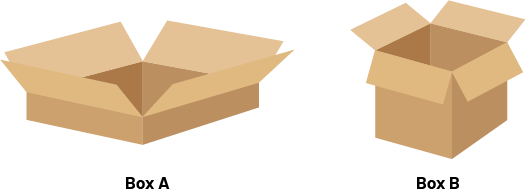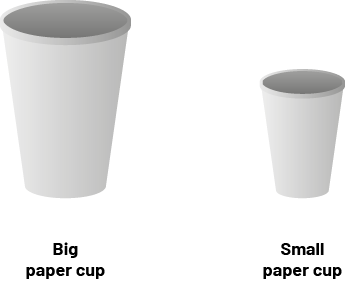E2.5 Use various units of different sizes to measure the same attribute of a given item, and demonstrate that even though using different-sized units produces a different count, the size of the attribute remains the same.
Activity 1: Use Different Sized Units to Measure Capacity
Here are two boxes.

Ask students to check the capacity of each of the boxes using the two paper cups filled with rice as a unit of measurement.
Ask the following questions.
- What do you notice?
- Does the capacity of the two boxes change when a different non-standard unit of measurement is used to measure it?

Source: adapted and translated from En avant, les maths! 3e année, CM, Sens de l'espace, p. 3-4.
Extension
Have students repeat the activity by measuring another measurable attribute such as the height or area of a surface of each box.
Activity 2: Demonstrate That the Size of an Attribute Remains Unchanged
Present students with the following situation.
Marko measured the length of a table and a book, and this is what he found.
The Length
|
Objects |
Non-Standard Units |
||
|
Counters |
Cubes |
Paper Clips |
|
|
Table |
41 |
34 |
about 20 |
|
Book |
about 16 |
13 |
about 7 |
He also measured the mass and the area of two other objects.
The Mass Measured With a Pan Balance Scale
|
Objects |
Non-Standard Units |
||
|
Cubes |
Counters |
Cork Stoppers |
|
|
Pencil sharpener |
about 21 |
43 |
31 |
|
Eraser |
about 19 |
39 |
about 28 |
The Area
|
Objects |
Non-Standard Units |
||
|
Sticky Notes |
Cubes |
Pattern Blocks |
|
|
Desk |
about 64 |
186 |
165 |
|
Book |
about 9 |
32 |
28 |
Ask the following questions.
- What do you notice?
- Does the size of the attributes (length, mass, and area) change when different non-standard units are used to measure it? Why?
Ask students to compare the number of units counted for each of the objects. Establish relationships between the number of units required to determine the measurement of an attribute and the length, area, or mass of the non-standard unit of measurement used.
